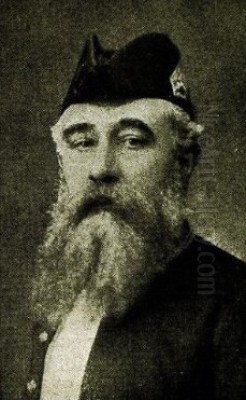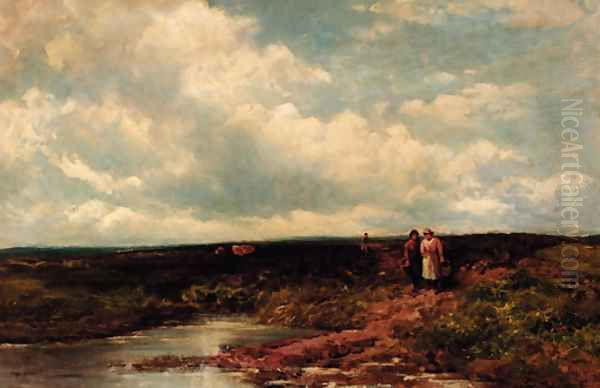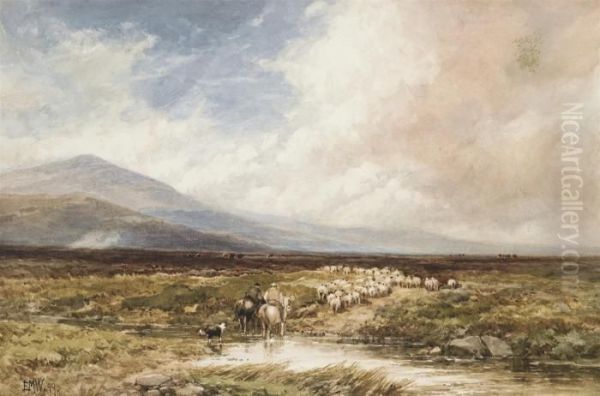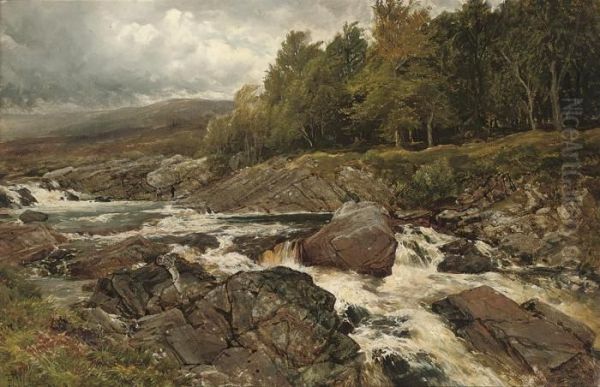
Edmund Morison Wimperis stands as a significant figure in the landscape of late Victorian British art. Primarily celebrated for his evocative watercolour paintings, he captured the mutable skies, rolling terrains, and rustic charm of the English and Welsh countryside with a distinctive sensitivity and technical skill. Born during a period of immense industrial change and artistic evolution, Wimperis navigated the worlds of commercial illustration and fine art, ultimately dedicating his mature career to landscape painting, leaving behind a body of work admired for its atmospheric depth and fidelity to nature.
Early Life and Artistic Beginnings
Edmund Morison Wimperis was born on February 6, 1835, in Flocker's Brook, Chester. He was the eldest of eight children born to Edmund Richard Wimperis, a cashier for a local firm, and his wife Mary (née Morison). Chester, an ancient city rich in history and surrounded by the gentle Cheshire landscape, may have provided early, albeit perhaps subconscious, inspiration for the future landscape artist. His initial path, however, was not directly into painting but into the burgeoning field of commercial wood engraving, a vital medium for illustration in the mid-19th century.
Around 1851, the young Wimperis moved to London, the epicentre of Britain's publishing and art world. He became an apprentice to the notable wood engraver Mason Jackson, who was heavily involved with the Illustrated London News. This apprenticeship provided Wimperis with rigorous training in draughtsmanship and the intricate techniques of translating images into printable wood blocks. This period was crucial in honing his observational skills and understanding of tone and composition, foundations that would serve him well in his later painting career.
The Illustrator's Craft
For approximately seven years, Wimperis worked professionally as a wood engraver. He contributed illustrations to prominent publications, including the widely circulated Illustrated London News and literary journals like The Athenaeum. This era saw a huge demand for illustrated material, feeding a public hungry for visual information and entertainment. Working alongside other skilled engravers and artists, Wimperis became adept at interpreting scenes and designs for mass reproduction.

His skills extended to book illustration, a prestigious field that brought visual life to popular literature. He is known to have created illustrations for editions of works by major Victorian novelists. Notably, he provided designs for editions of Charlotte Brontë's novels, including poignant watercolours for Jane Eyre and scenes potentially related to Wuthering Heights or Wildfell Hall. There is also evidence linking him to illustrations for the works of George Eliot, possibly contributing to the visual culture surrounding these literary giants. This work placed him within the orbit of the 'Sixties School' of illustration, a period noted for its high quality and artistic merit, involving artists like John Everett Millais and Frederick Sandys, though Wimperis's style remained distinct.
Transition to Painting: The Influence of Birket Foster
While wood engraving provided a steady career, Wimperis's artistic aspirations increasingly turned towards painting, particularly watercolour. Around 1857, seeking to develop his skills in this medium, he began studying landscape painting under Myles Birket Foster. Foster was already a highly successful and popular watercolourist, renowned for his charming, detailed, and often sentimental depictions of rural English life and scenery.
Foster's influence on Wimperis is discernible, particularly in the latter's earlier paintings. Wimperis adopted some of Foster's meticulous approach and preference for picturesque subject matter. However, Wimperis gradually developed his own distinct style, which, while retaining a certain delicacy, often possessed a broader handling and a more robust engagement with the wilder aspects of nature compared to Foster's consistently idyllic scenes. The transition marked a significant shift from the reproductive craft of engraving to the expressive potential of original painting.
Mastering the Watercolour Medium
Wimperis dedicated himself primarily to watercolour, a medium that enjoyed immense popularity and prestige in Victorian Britain, championed by societies like the Royal Watercolour Society (RWS) and the younger Royal Institute of Painters in Water Colours (RI). He excelled in capturing the specific atmospheric conditions of the British Isles – the fleeting effects of light and shadow under expansive, cloud-filled skies, the textures of moorland and forest, and the damp, diffused light characteristic of the climate.
His technique often involved direct observation and sketching outdoors, embracing the principles of en plein air painting, even if final works were completed in the studio. He became particularly adept at rendering broad, open landscapes, often featuring low horizons that emphasized dramatic cloud formations and the play of light across the land. His depiction of "broken ground" – uneven terrain, cart tracks, sandy banks, or heathland – was frequently noted by critics for its realism and textural quality. While capable of fine detail, his later work often showed a freer, more suggestive brushwork, effectively conveying mood and atmosphere without laborious precision.
The English Landscape: Favourite Haunts

Wimperis drew his primary inspiration from the diverse landscapes of Great Britain. While he undertook sketching tours in Wales, Devon, Cornwall, and the Home Counties, he developed a particular affinity for the New Forest in Hampshire. This ancient woodland, with its mix of heath, forest glades, and picturesque villages, provided him with endless subject matter. Works such as A Glade in the New Forest exemplify his ability to capture the unique character of this region – the interplay of light filtering through trees, the rough textures of the heath, and the sense of tranquil seclusion.
Other representative works highlight his engagement with different terrains and weather conditions. Across the Moor likely depicts the expansive, windswept landscapes found in areas like Dartmoor or the Welsh hills. Driving home the flock, Dartmoor captures a pastoral scene imbued with the specific sense of place. Titles like Windy Weather and A Torrent from the Hills, with Fishermen Beyond showcase his interest in depicting nature's more dynamic and untamed aspects, moving beyond the purely picturesque. His Wild Nature series, including pieces like A Patch of Heather and Ford at Brockenhurst Bridge, further underscores his commitment to rendering the specific flora and topography of his chosen locations.
Professional Recognition and Affiliations
Wimperis steadily gained recognition within the London art world. He began exhibiting his paintings in the late 1850s, showing works at major venues including the Royal Academy, the British Institution, and the galleries at Suffolk Street (home to the Society of British Artists). His primary allegiance, however, came to be with the watercolour societies.
In 1873, he was elected an Associate of the New Society of Painters in Water-colour, achieving full membership in 1875. This society, founded as an alternative to the more established RWS, was renamed the Royal Institute of Painters in Water Colours (RI) in 1881. Wimperis became a prominent figure within the RI, respected for his consistent contributions to their exhibitions and his artistic skill. His dedication was recognized when he was elected Vice-President of the RI in 1895, a position he held until his death. He was also associated with social groups like the Artists' Club.
His reputation extended beyond Britain. In 1889, he made his only documented trip abroad, visiting Saint-Malo in France. He exhibited work at the Paris Exposition Universelle (World's Fair) that year, participating in the artists' salon, where he was awarded a bronze medal, signifying international acknowledgment of his talent. His works were also exhibited elsewhere, including Zurich, demonstrating a reach beyond the domestic market.
Wimperis and His Contemporaries

Edmund Morison Wimperis worked during a vibrant and complex period in British art. His career spanned the dominance of the Pre-Raphaelites, the rise of Aestheticism, and the beginnings of Impressionist influences from France. While primarily a landscape watercolourist, his path intersected with various artistic circles.
His early training placed him alongside wood engravers like Mason Jackson and, by association, the influential Dalziel Brothers, who engraved works for many leading artists. His tutelage under Myles Birket Foster connected him to a popular tradition of detailed, picturesque landscape painting. Within the RI, he exhibited alongside fellow watercolourists who represented a spectrum of styles, from the detailed naturalism of artists like Helen Allingham, who also favoured charming rural scenes, to the broader, more atmospheric approaches of painters like Thomas Collier or Alfred William Hunt (though Hunt was more associated with the RWS).
Compared to the high detail and symbolic intensity of the Pre-Raphaelites like John Everett Millais or William Holman Hunt, Wimperis's work was more focused on capturing the transient effects of light and atmosphere in a naturalistic manner. His landscapes lacked the overt narrative or moralising content often found in Academic painting championed by figures like Frederic Leighton or Lawrence Alma-Tadema. Instead, Wimperis belonged to a strong native tradition of British landscape watercolour painting, tracing its lineage back through artists like Peter De Wint and David Cox, adapting it to Victorian sensibilities. He maintained a consistent vision, less experimental than some contemporaries but highly accomplished within his chosen idiom. Other notable figures in the illustration world he would have known included John Tenniel and William Luson Thomas.
Later Life and Legacy
Wimperis continued to paint and exhibit actively throughout his later years. According to biographical records, he married Ann Harry Cuthbertson in 1863, and they had several children, including Edmund Walter, Arthur Harold, Ethel Mary, and Mabel. (Note: Some earlier sources provided conflicting information regarding his marital status, but genealogical records confirm his marriage and family). In his final years, he resided for a time at the Southcliff Hotel in Southampton, perhaps drawn to the coastal light and proximity to the New Forest.
Edmund Morison Wimperis died on Christmas Day, December 25, 1900, in Bristol, at the age of 65. He left behind a significant legacy as a dedicated and skilled interpreter of the British landscape. His work bridged the gap between the detailed topographical tradition and a more atmospheric, expressive approach to watercolour. He captured the essence of the English countryside, particularly the southern counties and Wales, with affection and fidelity.
His paintings remain popular with collectors and are held in numerous public collections, including the Victoria and Albert Museum and the British Museum in London, as well as regional galleries like the Blackburn Museum and Art Gallery. His contribution lies in his mastery of the watercolour medium and his consistent dedication to depicting the natural beauty of Britain, offering a tranquil yet authentic vision of the landscape during a period of rapid change.
Representative Works: A Recap
Wimperis's oeuvre is characterised by its focus on landscape, rendered with sensitivity to light and atmosphere. Key works that represent his style and typical subjects include:
A Glade in the New Forest: Capturing the dappled light and sylvan charm of his favourite painting ground.
Across the Moor: Evoking the openness and potentially wilder character of moorland scenery.
Driving home the flock, Dartmoor: A pastoral scene grounded in a specific, rugged location.
Windy Weather: Demonstrating his ability to depict the dynamism of weather conditions.
A Torrent from the Hills, with Fishermen Beyond: Showing nature's power alongside human presence.
Near Ringwood: Likely another New Forest subject, focusing on the specific locality.
The Wild Nature series (including A Patch of Heather, Ford at Brockenhurst Bridge, Crossing Place near Brockenhurst): Highlighting his interest in the details and specific features of the natural landscape.
Queen's Bower (exhibited 1887): Another named location, likely within the New Forest, indicating his continued exploration of the area.
Illustrations for Brontë novels (e.g., Jane Eyre): Showcasing his earlier work translating literary scenes into visual form.
These titles reflect his enduring engagement with the British landscape, rendered through the fluid and expressive medium of watercolour.
Conclusion
Edmund Morison Wimperis carved a distinct niche for himself within the bustling Victorian art world. Starting in the demanding craft of wood engraving, he transitioned successfully into fine art, becoming a leading watercolourist of his generation. His strength lay in his sensitive observation of nature, particularly his ability to render the nuances of the British sky and the textures of the land. As Vice-President of the Royal Institute of Painters in Water Colours, he held a position of respect among his peers. Though perhaps not an innovator on the scale of Turner or Constable, Wimperis mastered his chosen medium and subject, creating landscapes that continue to resonate with their quiet beauty, atmospheric depth, and enduring affection for the British countryside. His work remains a testament to the enduring appeal of landscape painting and the technical brilliance achievable in watercolour.